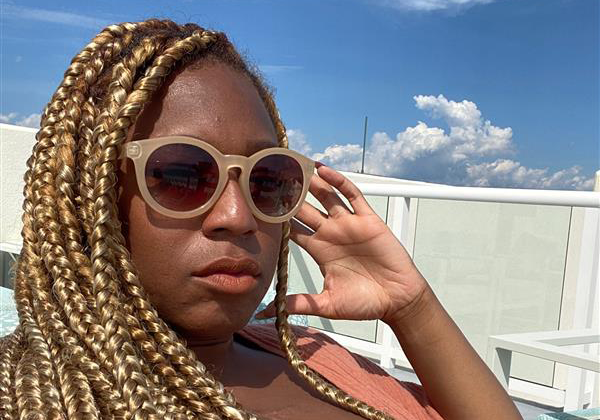3 Tips for Wearing “Protective Styles” with Your Natural Hair
Co-Founder, Aishia, sunbathing in her box braids in May 2021.
Whether it’s for vacation, preference, boredom, creative expression, or a break from our maintenance routines, “protective” hair styling allows us avoid the work of caring for our hair. These are supposedly low maintenance styles that can keep us looking polished when all else fails.
“Protective styling” is not really protective though.
For real? That’s right! We are not sure how wigs, weaves, crochet, faux locs, and braids have been dubbed protective styles. How are we protecting our hair when we are starving it from hydration, causing breakage due to friction, and allowing sweat/debris/skin cells build up on the scalp skin breeding bacteria and fungi along the way? What if we told you the most “protective” style is the one you can execute well and cleanse/condition/care for regularly every 7-10 days.
So, if they aren’t protective, what should these styles be called instead? We have coined these options “alternative” styles. They are an alternate option to wearing your real hair. They are luxury style options as they take even more maintenance than a regular style. You have to have a hair budget, time budget, and dollar budget to wear these styles successfully.
Listed below are 3 reasons why “protective styling” isn’t really protective:
While wearing an alternative style, the hair and scalp must be thoroughly cleaned regularly. This is often easier to outsource to a stylist who can properly see/feel their way to your scalp with product and their hands. Then it’s imperative that the additional hair and your hair be dried fully under hooded dryer. Failure to complete this step can cause mildew and molding at the scalp and within the crevices of the style as well as breed bacteria and fungi. The additional hair often needs restyling with heat or tools to look good again.
It is important to note that alternative style applications are best suited for hair that is already in a healthy hydrated state with an intact cuticle. Those with weak, thirsty, brittle, or damaged hair should avoid these styling options at all costs because friction and chronic dehydration are the enemies of compromised hair.
When going into any braids, weaves, twist, wigs etc. for an extended amount of time with dry, damaged hair, you will come out of those styles with even drier, more damaged hair. This is due to the friction applied by hair add on’s and dehydration from infrequent wash hour processes. Prior to any alternative styling involving the use of extension hair, your hair should be clean and deep conditioned with a quality moisturizing conditioner. If you think your hair needs a protein treatment prior to installation, your hair is not in the condition to receive alternative styling.
But listen, we’re no strangers to alternative styles! We can rock them just the same as ya’ll. Want to learn more? Make sure you subscribe to our email list.

